I READ SOME COMIC BOOKS THIS WEEK. HERE IS WHAT I THOUGHT OF THEM.
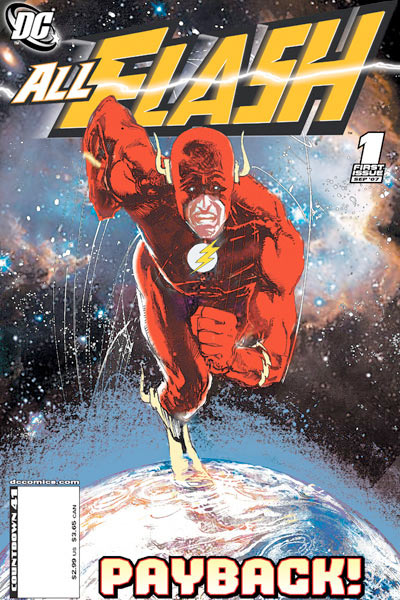 All Flash Comics #1: It’s so… awkward… and self-congratulatory. Ick. I want to say “Hey, Karl Kerschl’s art was the best thing about this” but then I’m sorta-friends with Karl and my opinion is suspect. I dunno. I was reading it and it’s exactly not-bad, not-good in the way that many (most?) superhero comics are these days. The multiple art teams, the overliance on history and continuity, the weird torture of the bad guys… None of it stood out as bad or good, it was just “here is a sequence of events that will keep you reading until next month”. Wow. There’s nothing there for people who aren’t long-time, die-hard fans of the character, and even though I’m somewhere in that sphere I was just… I don’t like this at all. And the cover by Seinkewicz is… distressing.
All Flash Comics #1: It’s so… awkward… and self-congratulatory. Ick. I want to say “Hey, Karl Kerschl’s art was the best thing about this” but then I’m sorta-friends with Karl and my opinion is suspect. I dunno. I was reading it and it’s exactly not-bad, not-good in the way that many (most?) superhero comics are these days. The multiple art teams, the overliance on history and continuity, the weird torture of the bad guys… None of it stood out as bad or good, it was just “here is a sequence of events that will keep you reading until next month”. Wow. There’s nothing there for people who aren’t long-time, die-hard fans of the character, and even though I’m somewhere in that sphere I was just… I don’t like this at all. And the cover by Seinkewicz is… distressing.
Batman: Harley & Ivy TPB: This collection of three disparate stories featuring Harley Quinn and Poison Ivy is pretty fun stuff, with some nice art through and through. Has anyone ever looked at the subtext… or even the text… of these stories though? Yikes. It’s exactly “Dudes who are attracted to hawt cartoon characters put them into vaguely pervy situations for their own edification,” which is… every single female hero or villain in comics? It’s fun, just don’t read too deeply into… any… of it. Like the women-in-prison-flight ‘homage’ at the beginning of the second chapter of the titular mini-series, where the butch lesbian prison guards get rough with our two hot antiheroines. Actually, that whole last mini-series feels like Paul Dini letting loose after too many years dealing with cartoon censors and Hollywood… It’s interesting, and like I said, fun… if you don’t think too hard about it. Mmmm… probably not for kids.
 Big Plans #1: This is a Xeric-grant winning comic that we got in because we more-or-less support every Xeric Comic. It’s a mini-comic though, which is kind of weird, because I’d always assumed that the Xeric thing was to help you do something a little more professional than something that looks like it came off of the Xerox machine. The comics themselves are interesting, each page a six-panel staccato with lots of white-space elevating stories of the mundane into the… what’s less than profound but still pretty interesting? Well-observed, anyway, particularly the terrorism story. If I picked this up at MoCCA for $2, I’d be pretty happy. For it to be solicited through Diamond at $5, I’m less happy. There’s just not enough to it to justify the price tag, and I can’t help thinking that the author’s chosen format won’t really help him get noticed, let alone further develop his career. Maybe I’m wrong, maybe there’s a whole industry for stapled 5.5″x4.25″ comics that I’m unaware of. That are also available at http://www.aronnelssteinke.com/ entirely for free. But yeah, this is one where the format disappointed me much more than I enjoyed the actual content.
Big Plans #1: This is a Xeric-grant winning comic that we got in because we more-or-less support every Xeric Comic. It’s a mini-comic though, which is kind of weird, because I’d always assumed that the Xeric thing was to help you do something a little more professional than something that looks like it came off of the Xerox machine. The comics themselves are interesting, each page a six-panel staccato with lots of white-space elevating stories of the mundane into the… what’s less than profound but still pretty interesting? Well-observed, anyway, particularly the terrorism story. If I picked this up at MoCCA for $2, I’d be pretty happy. For it to be solicited through Diamond at $5, I’m less happy. There’s just not enough to it to justify the price tag, and I can’t help thinking that the author’s chosen format won’t really help him get noticed, let alone further develop his career. Maybe I’m wrong, maybe there’s a whole industry for stapled 5.5″x4.25″ comics that I’m unaware of. That are also available at http://www.aronnelssteinke.com/ entirely for free. But yeah, this is one where the format disappointed me much more than I enjoyed the actual content.
Captain America #28: This one felt a bit like a place-holder issue, particularly after the starling revelations and non-stop action of last issue. It’ll read better in the trade. Aside from the bad guys showing you they’re bad by killing a lot of people, and Sharon Carter awkwardly dancing around a few questions… yeah. Brubaker’s setting up the pieces in this issue, which didn’t really grab me the way that the rest of the arc has. Even though it came out a few weeks ago I finally read the newest issue of CRIMINAL, which was similar (setting up the pieces, pulling together the plot, showing what a bad ass you are) and it worked far, far better.
Comics Journal #284: I’ve only skimmed this so far, but man, do I not care about Roger Landridge at all. There’s just nothing there that I find interesting. Anyway, somehow I got sucked into reading Tom Crippen’s piece on the fanboy inside all of us and that was just brutal. Like, massively depressive, mostly because you could insert “There but for the grace of God, go I” after every paragraph. I haven’t seen any online reaction to this column yet–maybe The Journal has stopped being relevant for that sort of thing, I don’t see them stirring up much controversy lately unless it’s fucking with Harlan Ellison–but I’d be curious what anyone else thought. But yeah, I’ve not read much of the rest of it yet. The Gene Yang interview is on my list though.
Don’t Say Anymore Darling: This is a new collection of old short stories from Fumi Yoshinaga, the author of Antique Bakery. It’s mostly yaoi-centric (though there is at least one entirely straight short-story about a marriage that fails due to… well… the crazy, I think) and fans of Yoshinaga’s gentle, humanistic storytelling will probably love this as much as they love everything else she does. Mmm… me included. Granted, I read this while sick in bed with a head-cold so my retention isn’t entirely there, but the stories are all strong little shorts, usually with a nice shock right at the ending to cast the whole thing in a new light just as you end the chapter. I hope the existance of these interesting, sort of random works means that Ms. Yoshinaga is fabulously wealthy and gets to do whatever she wants with manga; I’ll happily keep reading.
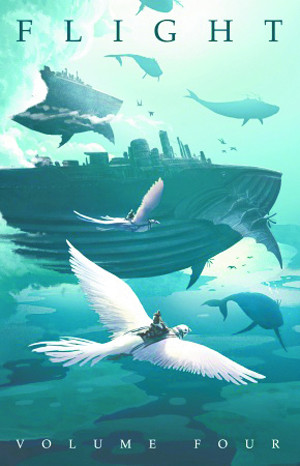 Flight Volume 4 GN: Reviewing this is basically impossible since 1/3 of the contributors at any given time are friends of mine, but here goes: Another strong entry in the Flight series. More gorgeous art, more lyrical short stories, definitely worth the cover price. The stand-outs are, once again, Clio Chang (this time with a meta-commentary take on the nature of fables) and Kazu Kibuishi (his story featuring duty and tradition butting heads with desire). It’s a handsomely designed and thoughtfully edited collection, each story sticking around just long enough to be enjoyable, and occasionally leaving you wanting more. I’d have hoped though, 5 years in, to see more of the contributors to the book making more of a name for themselves in the industry outside of the anthology. It still seems like a lot of the breakthrough work is in the pipeline, and as nice as 8-24 pages of work is from many of these creators, I feel like 150 pages of the same is what I really want.
Flight Volume 4 GN: Reviewing this is basically impossible since 1/3 of the contributors at any given time are friends of mine, but here goes: Another strong entry in the Flight series. More gorgeous art, more lyrical short stories, definitely worth the cover price. The stand-outs are, once again, Clio Chang (this time with a meta-commentary take on the nature of fables) and Kazu Kibuishi (his story featuring duty and tradition butting heads with desire). It’s a handsomely designed and thoughtfully edited collection, each story sticking around just long enough to be enjoyable, and occasionally leaving you wanting more. I’d have hoped though, 5 years in, to see more of the contributors to the book making more of a name for themselves in the industry outside of the anthology. It still seems like a lot of the breakthrough work is in the pipeline, and as nice as 8-24 pages of work is from many of these creators, I feel like 150 pages of the same is what I really want.
Ghost Rider #13 WWH: I haven’t been “reading” Ghost Rider, so I’m assuming that there’s just someone inexperienced or whatever behind the mantle of the character right now, making the first 2/3 of the book an “inexperienced hero fights Hulk in comedy of errors” routine that was occasionally chuckle-worthy. It all comes down to earth at the end though, when we’re reminded that Iron Man is a bastard, and the Hulk is rightfully seeking Vengence on him, leaving The Ghost Rider to fuck off back out of the crossover. Not bad, I guess? Funny, but hardly essential.
Programme #1: Winner of the “Comic that would most be benefitted by re-reading” award of the week. I think I liked this, all gritty, dirty cold war paranoia mixed with ongoing wars and impotent hulking Americans. I’m not sure though, as scenes rarely last for longer than a page or two, and writer Peter Milligan has had some spectacular misfires as of late. But yeah, despite Jog’s excellent breakdown, I kind of want to figure out what’s going on here for myself, and sadly the cursory reading given to FLASH or GHOST RIDER simply won’t do. At least you’re getting your 3 bucks worth.
Shazam: The Monster Society Of Evil #4: The ham-handed political nature of the story is toned-down just enough to be enjoyable rather than distracting, leading to a fun, over-the-top conclusion. Smith has picked up a few tricks out of contemporary young adult fiction here, making the adults-don’t-believe-kids stuff just annoying enough as to make the kid in me want to jump up-and-down in place going COME ON ALREADY!, which means it’s working. The ending has plenty of heroics, gross moments, a monster-punching or two, and sets the stage for great things to come… which is why what comes next is so depressing. (“Hey kids! That character you just grew to love? HE’S DEAD NOW. Also, his little sister has grown up into a goth cheerleader. Enjoy!”) I’m also wondering about the artificiciality of serialization breaks and their negative effect on the story… but that’s for a bigger discussion down the road.
The Order #1: Sorry Matt. Nothing here grabbed me. And I was actively put-off by the colouring, which couldn’t decide if the lead dude was grey-at-the-temples or not. I’ll read the next issue I guess, but this wasn’t your best stuff and I really, really want Casanova #8 now.
Warren Ellis’ Black Gas 2 #3: I still, honestly, can’t believe that Ellis would let a comic be named after his (presumably) deadly farts. Did no one think about what this would be called? Or maybe they did, and that’s perhaps worse. Ah well. BLEAK! SO FUCKING BLEAK! And, if the gas makes everyone crazy and itching to fuck, how did they all manage to pair off into neat boy/girl pairs? Isn’t that… fortunate? I guess? That the zombies don’t have to have the added stress of having their sexual identities challenged? “Fuck, I just tore the face off that guy but at least I’m shagging the dismembered lower-half of a woman instead of being some faggot zombie!” Ah well. it’s Avatar, you get what you pay for, you just usually get it very late.
World War Hulk #2: Totally enjoyable. Whenever anyone asks me if this is any good (specifically because Avengers Disassembled, House of M, and Civil War weren’t) all I need to say is “Well, Hulk DOES Smash.” I don’t go out of my way to promote this because, quite frankly, I don’t have to. Hulk fucks shit up, which is really all you need from a Hulk comic in the first place and that most stringent of conditions is met? People gladly part with their four dollars. Hulk Smash.
—
I also ready a bunch of stuff from previous weeks like SILVERFISH (alright), PHONOGRAM (alright I think, not sure about it), and some assorted manga. i guess being sick has it’s up-sides.
– Christopher
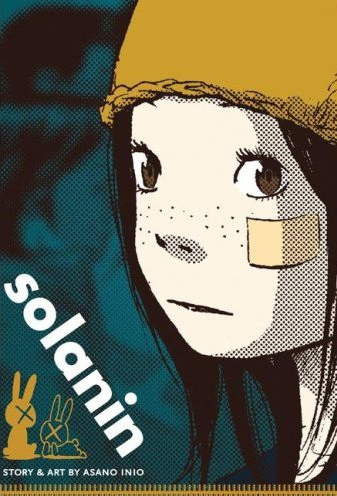 Just gotta take a second to disagree with Jog on his review (link) of the new Viz release solanin, by Isio Asano. It’s a well-written review, but it comes to conclusions between 90 and 180 degrees from my own. Admittedly, your patience for stories about young people that don’t know what they want to do with their lives is ultimately the deciding factor in whether or not you might enjoy this one. But… yeah, I loved it. solanin is like Scott Pilgrim but without the video game realism, and twice as much of the drama.
Just gotta take a second to disagree with Jog on his review (link) of the new Viz release solanin, by Isio Asano. It’s a well-written review, but it comes to conclusions between 90 and 180 degrees from my own. Admittedly, your patience for stories about young people that don’t know what they want to do with their lives is ultimately the deciding factor in whether or not you might enjoy this one. But… yeah, I loved it. solanin is like Scott Pilgrim but without the video game realism, and twice as much of the drama.

 Moresukine
Moresukine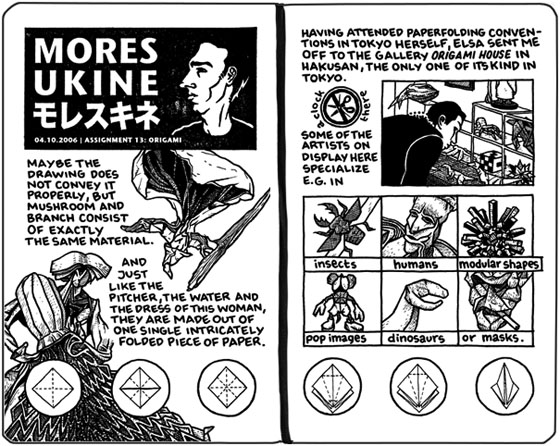
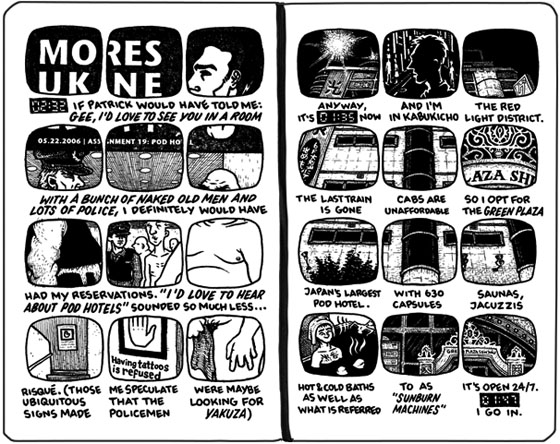
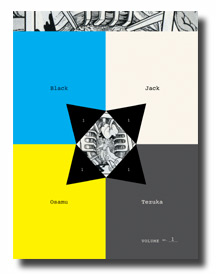 Black Jack Volume 1
Black Jack Volume 1
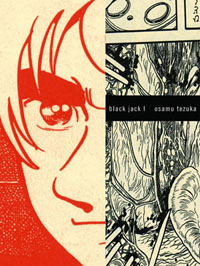 Black Jack doesn’t really work as a historical record, or a reflection of the time in which it was created because of the re-drawing and re-sequencing, and I think that the earlier Vertical Tezuka releases are where you would want to go for that… But considering Vertical’s ultra-contemporary book design choices and packaging, it seems that they aren’t interested in presenting Black Jack as a historical document anyway. The bold graphic design on this book is almost non-representational, a small piece of Tezuka’s art depicting the inside of a body is obscured and cropped so as to appear nearly abstract; the back cover features a sprawling futuristic industrial complex built from Lego. This is not being presented as a record of manga’s glorious past, but as a vital and engaging contemporary work. It reminds me of Viz’s handling of their recent release Cat-Eyed Boy, actually, in eschewing a historical connection almost entirely. To that end, volume one of Black Jack is entirely devoid of any sort of historical or academic context… the stories run right to the very last page of the book, endpapers be damned. I understand this decision of course, but I ultimately disagree with it: the stories don’t work presented as contemporary entertainment. They’re simply a little too unsophisticated for a generation of readers who are familiar with shows like ‘House.’ The formula is exactly, exactly the same of course, with the mysterious taciturn brusque brilliant surgeon solving the rare medical condition of the week, but the lengths to which Black Jack’s surgical prowess are stretched could snap a suspension-bridge of disbelief… But they’re totally fun, totally engrossing. Black Jack is a page-turner of the highest order, and I blew through 280+ pages and I’m hungry for more. I just feel that, seeing as this is the 20th-or-so Tezuka graphic novel I’ve read, I’m one of the initiated, I’m on board. As such, I’m the kind of reader that wants to know as much about this character and this world as possible, and I want a killer piece of Tezuka art on the cover too!
Black Jack doesn’t really work as a historical record, or a reflection of the time in which it was created because of the re-drawing and re-sequencing, and I think that the earlier Vertical Tezuka releases are where you would want to go for that… But considering Vertical’s ultra-contemporary book design choices and packaging, it seems that they aren’t interested in presenting Black Jack as a historical document anyway. The bold graphic design on this book is almost non-representational, a small piece of Tezuka’s art depicting the inside of a body is obscured and cropped so as to appear nearly abstract; the back cover features a sprawling futuristic industrial complex built from Lego. This is not being presented as a record of manga’s glorious past, but as a vital and engaging contemporary work. It reminds me of Viz’s handling of their recent release Cat-Eyed Boy, actually, in eschewing a historical connection almost entirely. To that end, volume one of Black Jack is entirely devoid of any sort of historical or academic context… the stories run right to the very last page of the book, endpapers be damned. I understand this decision of course, but I ultimately disagree with it: the stories don’t work presented as contemporary entertainment. They’re simply a little too unsophisticated for a generation of readers who are familiar with shows like ‘House.’ The formula is exactly, exactly the same of course, with the mysterious taciturn brusque brilliant surgeon solving the rare medical condition of the week, but the lengths to which Black Jack’s surgical prowess are stretched could snap a suspension-bridge of disbelief… But they’re totally fun, totally engrossing. Black Jack is a page-turner of the highest order, and I blew through 280+ pages and I’m hungry for more. I just feel that, seeing as this is the 20th-or-so Tezuka graphic novel I’ve read, I’m one of the initiated, I’m on board. As such, I’m the kind of reader that wants to know as much about this character and this world as possible, and I want a killer piece of Tezuka art on the cover too!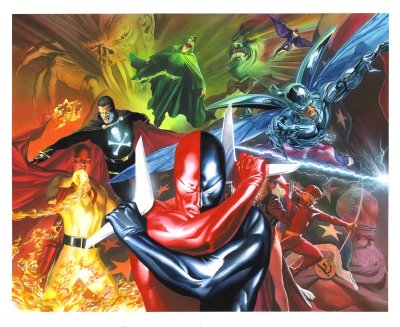
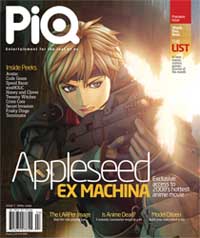 I think it’s important to point out that in the first issue of PiQ, the magazine calls its readership the following names: nerds, dorks, geeks, freaks, maniacs, and pervos.
I think it’s important to point out that in the first issue of PiQ, the magazine calls its readership the following names: nerds, dorks, geeks, freaks, maniacs, and pervos. Tokyo Is My Garden
Tokyo Is My Garden Though the official release date isn’t until today, The Best American Comics 2007 can already be found on store shelves everywhere, be they ‘comic’, ‘book’, or virtual. In fact, even before this Chris Ware guest-edited volume was available, the vast majority of the works in this volume could be found on the bookshelves of any artcomix fan who was paying attention from August 2005 through August 2006. Even though the raison d’etre of the Best American series of anthologies is to scour the totality of printed material for good works, the 2007 Comics edition is particularly notable for drawing the majority of its material from the output of publisher Fantagraphics books, and in particular their anthology Mome makes a very strong showing. In fact, upon receiving the book a few days back one of my more outspoken retail compatriots remarked (with a good measure of actual anger) that there was nothing for him in this book, since he’d already bought all of the Mome volumes, Kramer’s Ergot, and Charles Burns’ Black Hole. It’s actually that anger, which I’ve heard from more than a few people now, that made me want to review this volume and Mr. Ware’s examples of the best of comics in 2006.
Though the official release date isn’t until today, The Best American Comics 2007 can already be found on store shelves everywhere, be they ‘comic’, ‘book’, or virtual. In fact, even before this Chris Ware guest-edited volume was available, the vast majority of the works in this volume could be found on the bookshelves of any artcomix fan who was paying attention from August 2005 through August 2006. Even though the raison d’etre of the Best American series of anthologies is to scour the totality of printed material for good works, the 2007 Comics edition is particularly notable for drawing the majority of its material from the output of publisher Fantagraphics books, and in particular their anthology Mome makes a very strong showing. In fact, upon receiving the book a few days back one of my more outspoken retail compatriots remarked (with a good measure of actual anger) that there was nothing for him in this book, since he’d already bought all of the Mome volumes, Kramer’s Ergot, and Charles Burns’ Black Hole. It’s actually that anger, which I’ve heard from more than a few people now, that made me want to review this volume and Mr. Ware’s examples of the best of comics in 2006.
 Big Plans #1: This is a Xeric-grant winning comic that we got in because we more-or-less support every Xeric Comic. It’s a mini-comic though, which is kind of weird, because I’d always assumed that the Xeric thing was to help you do something a little more professional than something that looks like it came off of the Xerox machine. The comics themselves are interesting, each page a six-panel staccato with lots of white-space elevating stories of the mundane into the… what’s less than profound but still pretty interesting? Well-observed, anyway, particularly the terrorism story. If I picked this up at MoCCA for $2, I’d be pretty happy. For it to be solicited through Diamond at $5, I’m less happy. There’s just not enough to it to justify the price tag, and I can’t help thinking that the author’s chosen format won’t really help him get noticed, let alone further develop his career. Maybe I’m wrong, maybe there’s a whole industry for stapled 5.5″x4.25″ comics that I’m unaware of. That are also available at
Big Plans #1: This is a Xeric-grant winning comic that we got in because we more-or-less support every Xeric Comic. It’s a mini-comic though, which is kind of weird, because I’d always assumed that the Xeric thing was to help you do something a little more professional than something that looks like it came off of the Xerox machine. The comics themselves are interesting, each page a six-panel staccato with lots of white-space elevating stories of the mundane into the… what’s less than profound but still pretty interesting? Well-observed, anyway, particularly the terrorism story. If I picked this up at MoCCA for $2, I’d be pretty happy. For it to be solicited through Diamond at $5, I’m less happy. There’s just not enough to it to justify the price tag, and I can’t help thinking that the author’s chosen format won’t really help him get noticed, let alone further develop his career. Maybe I’m wrong, maybe there’s a whole industry for stapled 5.5″x4.25″ comics that I’m unaware of. That are also available at  Flight Volume 4 GN: Reviewing this is basically impossible since 1/3 of the contributors at any given time are friends of mine, but here goes: Another strong entry in the Flight series. More gorgeous art, more lyrical short stories, definitely worth the cover price. The stand-outs are, once again, Clio Chang (this time with a meta-commentary take on the nature of fables) and Kazu Kibuishi (his story featuring duty and tradition butting heads with desire). It’s a handsomely designed and thoughtfully edited collection, each story sticking around just long enough to be enjoyable, and occasionally leaving you wanting more. I’d have hoped though, 5 years in, to see more of the contributors to the book making more of a name for themselves in the industry outside of the anthology. It still seems like a lot of the breakthrough work is in the pipeline, and as nice as 8-24 pages of work is from many of these creators, I feel like 150 pages of the same is what I really want.
Flight Volume 4 GN: Reviewing this is basically impossible since 1/3 of the contributors at any given time are friends of mine, but here goes: Another strong entry in the Flight series. More gorgeous art, more lyrical short stories, definitely worth the cover price. The stand-outs are, once again, Clio Chang (this time with a meta-commentary take on the nature of fables) and Kazu Kibuishi (his story featuring duty and tradition butting heads with desire). It’s a handsomely designed and thoughtfully edited collection, each story sticking around just long enough to be enjoyable, and occasionally leaving you wanting more. I’d have hoped though, 5 years in, to see more of the contributors to the book making more of a name for themselves in the industry outside of the anthology. It still seems like a lot of the breakthrough work is in the pipeline, and as nice as 8-24 pages of work is from many of these creators, I feel like 150 pages of the same is what I really want.